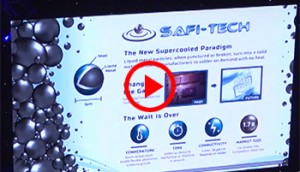Newsletter - Volume 2 Issue 2

 In this issue:
In this issue:
- Liquid Metal Technology
- Closed circuit cooling
- Cooling a textile machine
- SlimLine Vario - variable speed A/C
Featured video: Supercooled liquid metal particle technology for industries

Liquid Metal Technology
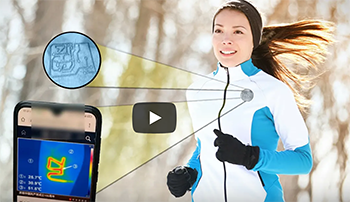 New technology can lead to advances in industries beyond the uses that were initially envisioned for that technology. It is with this in mind that this newsletter presents some technology news items that are currently outside the enclosure industry.
New technology can lead to advances in industries beyond the uses that were initially envisioned for that technology. It is with this in mind that this newsletter presents some technology news items that are currently outside the enclosure industry.
The video at the top shows an initial intended application for liquid metal. Other potential applications include microprocessor to heat sink fixation and flexible circuitry for use in clothing that could lead to heating and cooling properties embedded in the clothing. (See video.)
What is liquid metal? It is a metal alloy that is liquid at or nearly at "room temperature."
Paraphrasing an article in Elsevier publication Science Direct, "liquid metal cooling technologies [used] in conventional convection cooling systems, act as the coolant and are driven by external forces (such as an electromagnetic pump)."
A patent for a liquid metal air conditioner cooling system describes a system that claims to increase efficiency as well as cooling capacity.
A liquid-metal-based air cooling system is described that seemingly combines a compressor-driven air conditioning system with a heat exchanger. The liquid metal is used for the liquid conducting heat in the heat exchanger.
Sources:
1. https://www.sciencedirect.com/science/article/abs/pii/S0065271718300030
2. https://www.youtube.com/watch?v=or1Tci4Wzzc
3. https://www.safi-tech.com/

Closed circuit cooling
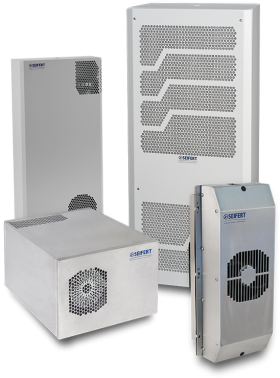 If your application is installed in an environment with high ambient temperatures, oil and dust exposure, and you have high splash proof requirements (NEMA / IP), then it becomes absolutely necessary to prevent the ambient air from entering the enclosure. A cooling system with closed loop cooling normally consists of 2 loops; one loop closes the ambient air off and cools and circulates clean air into the enclosure. The second loop uses the ambient air or water to dissipate the heat. For these applications cooling units and air/water heat exchangers are normally used.
If your application is installed in an environment with high ambient temperatures, oil and dust exposure, and you have high splash proof requirements (NEMA / IP), then it becomes absolutely necessary to prevent the ambient air from entering the enclosure. A cooling system with closed loop cooling normally consists of 2 loops; one loop closes the ambient air off and cools and circulates clean air into the enclosure. The second loop uses the ambient air or water to dissipate the heat. For these applications cooling units and air/water heat exchangers are normally used.
General rules:
- the only method to reduce enclosure temperature below ambient temperature (using cooling units and air / water heat exchangers)
- suitable for NEMA /IP requirements
- during planning you need to take the ambient temperature and the generated power loss into consideration. For outdoor applications, please also consider the solar load.(check the performance charts of the product you want to use to ensure that your system temperature is properly maintained)
The right selection of a cooling unit is determined by the following criteria:
- required cooling capacity in Watt
- max. ambient air temperature and desired enclosure air temperature
- mounting requirements (wall, recessed or top mount)
- dimensions of cooling unit and enclosure
- mounting location (indoor, outdoor, shading, etc.)
The following simple formula calculates the necessary cooling power:
Pk = Pv - Pr
Pk [W] = Cooling capacity of the unit
Pv [W] = Power loss (thermal power generated inside an enclosure by the dissipation loss of components)
Pr [W] = Radiant heat gain/loss (heat transfer through the outer body of the enclosure)
The following formula calculates the heat gain/loss:
Pr = k x A x ≜T
k [W/m2K] = Coefficient of heat transmission
A [m2] = Enclosure surface area
≜T [K] = Temperature difference between ambient air and internal enclosure air
Important information when utilizing cooling units:
- The enclosure should be sealed to prevent the inflow of ambient air.
- The NEMA /IP rating of the cooling unit and the enclosure should be the same.
- Use a door contact switch to prevent operation with open doors and consequent excessive accumulation of condensation.
- Ensure that the air inflow and air outflow in the external circuit are not obstructed which would prevent proper heat exchanging at the condenser.
- It also must be ensured that components with a high level of self-ventilation do not direct the air into the cold air outlet of the cooling device.
- Ensure the unit stands straight.
- Setting the temperature to the lowest is not always the best solution. The pre-set value of +35°C is a good compromise ensuring long life of electrical components, efficient operation and minimum condensation. This might also vary depending on the application.

Cooling a textile machine
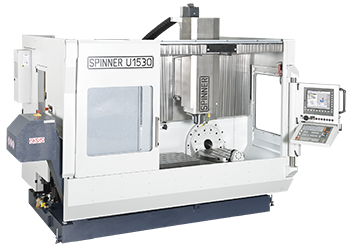 A textile processing machine that is used to spin material into yarn required cooling. A Seifert ComPact Line air conditioner model KG 4305 recessed was selected by the machine manufacturer to cool their machine. This model of ComPact has a 550 W cooling capacity and was easily integrated into the Spinner machine.
A textile processing machine that is used to spin material into yarn required cooling. A Seifert ComPact Line air conditioner model KG 4305 recessed was selected by the machine manufacturer to cool their machine. This model of ComPact has a 550 W cooling capacity and was easily integrated into the Spinner machine.

SlimLine Vario - variable speed A/C
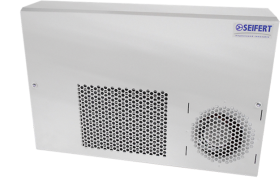 The SlimLine Vario's compact compressor can be adjusted to the required cooling capacity with variable speed via a controller, therefore only consumes the amount of electricity that is actually required to cool the current power losses.
The SlimLine Vario's compact compressor can be adjusted to the required cooling capacity with variable speed via a controller, therefore only consumes the amount of electricity that is actually required to cool the current power losses.
By continuously adapting the cooling capacity, a very constant enclosure temperature is achieved which means the electronic components and the cooling unit are significantly less stressed. In addition, the formation of condensate inside the enclosure is minimized.
All of this leads to higher operational reliability, longer service life and a energy savings of more than 70%. Seifert variable speed cooling air conditioners set a new standard of "cooling performance." The micro channel condenser uses significantly less refrigerant and thus a reduction in the CO2 equivalent.
They are listed as UL Type 12.
Learn more.
If you have a question about enclosure cooling for your specific application, Seifert Systems' technical staff would be glad to speak with you. Email us at info.us@seifertsystems.com or call 401-294-6960 .
Please email suggestions for technical subjects you would like to suggest for this newsletter to this link: Newsletter Editor
